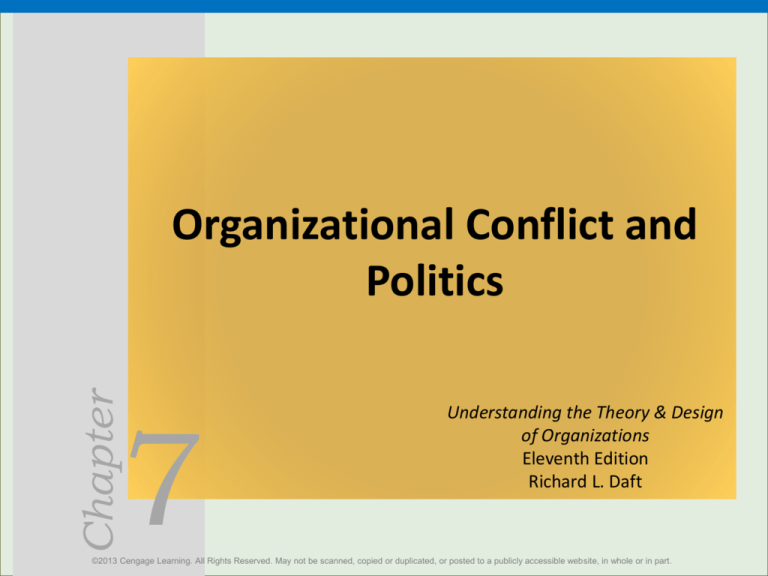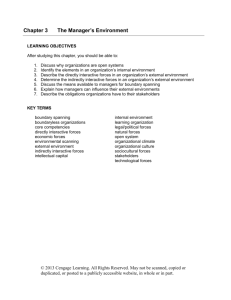
Chapter
Organizational Conflict and
Politics
7
Understanding the Theory & Design
of Organizations
Eleventh Edition
Richard L. Daft
©2013 Cengage Learning. All Rights Reserved. May not be scanned, copied or duplicated, or posted to a publicly accessible website, in whole or in part.
Interdepartmental Conflict in Organizations
•
•
Groups may be dispersed across the
organization
Intergroup conflict requires three
ingredients:
1. Group Identification
2. Observable Group Differences
3. Frustration
Conflict is similar to competition but more severe
2
©2013 Cengage Learning. All Rights Reserved. May not be scanned, copied or duplicated, or posted to a publicly accessible website, in whole or in part.
Sources of Conflict
Goal Incompatibility
Differentiation
Task Interdependence
Limited Resources
3
©2013 Cengage Learning. All Rights Reserved. May not be scanned, copied or duplicated, or posted to a publicly accessible website, in whole or in part.
Marketing-Manufacturing Areas of
Potential Goal Conflict
4
©2013 Cengage Learning. All Rights Reserved. May not be scanned, copied or duplicated, or posted to a publicly accessible website, in whole or in part.
Rational versus Political Model
• The rational model where behavior is not
random or accidental
– Goals are clear and choices are made logically
• The political model involves push and pull
debate regarding goals
– Organization groups have separate interests and
goals
5
©2013 Cengage Learning. All Rights Reserved. May not be scanned, copied or duplicated, or posted to a publicly accessible website, in whole or in part.
Sources of Conflict and Use of Rational
versus Political Model
6
©2013 Cengage Learning. All Rights Reserved. May not be scanned, copied or duplicated, or posted to a publicly accessible website, in whole or in part.
Top 10 Problems from
Too Much Conflict
©2013 Cengage Learning. All Rights Reserved. May not be scanned, copied or duplicated, or posted to a publicly accessible website, in whole or in part.
Tactics for Enhancing Collaboration
1. Create integration devices
2. Use confrontation and negotiation
3. Schedule intergroup consultation
4. Practice member rotation
5. Create shared mission and superordinate
goals
8
©2013 Cengage Learning. All Rights Reserved. May not be scanned, copied or duplicated, or posted to a publicly accessible website, in whole or in part.
Negotiation Strategies
9
©2013 Cengage Learning. All Rights Reserved. May not be scanned, copied or duplicated, or posted to a publicly accessible website, in whole or in part.
Power and Organizations
• Power is the potential ability of one person to
influence other people
• Individual versus Organizational Power
– Legitimate Power
– Reward Power
– Coercive Power
– Expert Power
– Referent Power
10
©2013 Cengage Learning. All Rights Reserved. May not be scanned, copied or duplicated, or posted to a publicly accessible website, in whole or in part.
Power versus Authority
Authority is more narrow than power
– Defined by the formal hierarchy and reporting
relationships
1) Authority is vested in organizational positions
2) Authority is accepted by subordinates
3) Authority flows down the vertical hierarchy
•
Power can be exercised upward, downward, and
horizontally
•
Authority is exercised downward along the
hierarchy
11
©2013 Cengage Learning. All Rights Reserved. May not be scanned, copied or duplicated, or posted to a publicly accessible website, in whole or in part.
Vertical Sources of Power
• Formal Position – legitimate power accrued to top
positions
• Resources – resources can be used as a tool for
power
• Control of Information – information is a primary
business source
• Network Centrality – being centrally located in the
organization and having access
• People – loyal executives/managers
12
©2013 Cengage Learning. All Rights Reserved. May not be scanned, copied or duplicated, or posted to a publicly accessible website, in whole or in part.
Information Flow for Computer
Decision at Clark Ltd.
13
©2013 Cengage Learning. All Rights Reserved. May not be scanned, copied or duplicated, or posted to a publicly accessible website, in whole or in part.
Illustration of Network Centrality
14
©2013 Cengage Learning. All Rights Reserved. May not be scanned, copied or duplicated, or posted to a publicly accessible website, in whole or in part.
The Power of Empowerment
• Power sharing, the delegation of power or
authority to subordinates
• Empowerment benefits:
– Employees receive information about company
performance
– Employees have knowledge and skills to contribute
to company goals
– Employees have the power to make substantive
decisions
15
©2013 Cengage Learning. All Rights Reserved. May not be scanned, copied or duplicated, or posted to a publicly accessible website, in whole or in part.
Horizontal Sources of Power
• Relationships across departments, divisions,
units
• Strategic Contingencies – groups most
responsible for key organization issues
• Power Sources – five power sources that
departments may possess
16
©2013 Cengage Learning. All Rights Reserved. May not be scanned, copied or duplicated, or posted to a publicly accessible website, in whole or in part.
Ratings of Power among Departments
in Industrial Firms
17
©2013 Cengage Learning. All Rights Reserved. May not be scanned, copied or duplicated, or posted to a publicly accessible website, in whole or in part.
Strategic Contingencies That Influence
Horizontal Power among Departments
18
©2013 Cengage Learning. All Rights Reserved. May not be scanned, copied or duplicated, or posted to a publicly accessible website, in whole or in part.
Political Processes in Organizations
• Politics is the use of power to influence decisions
toward goals
• Organizational Politics - activities to acquire,
develop, and use power to influence goals
• Domains of political activity:
– Structural Change
– Management Succession
– Resource Allocation
19
©2013 Cengage Learning. All Rights Reserved. May not be scanned, copied or duplicated, or posted to a publicly accessible website, in whole or in part.
Power and Political Tactics in Organizations
20
©2013 Cengage Learning. All Rights Reserved. May not be scanned, copied or duplicated, or posted to a publicly accessible website, in whole or in part.
Design Essentials
Conflict, power, and politics are natural outcomes of
organizing
There are two views for organizations: rational and
political models
There are vertical and horizontal sources of power
Certain characteristics make some departments more
powerful than others
Managers need political skills
Managers should enhance collaboration to reduce
conflict
21
©2013 Cengage Learning. All Rights Reserved. May not be scanned, copied or duplicated, or posted to a publicly accessible website, in whole or in part.








